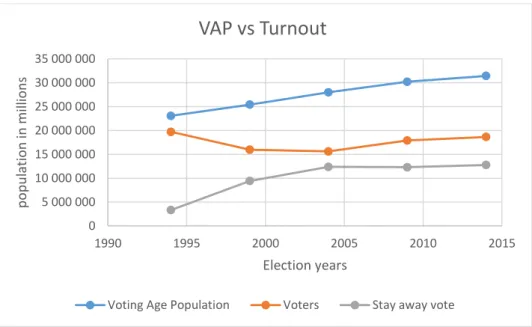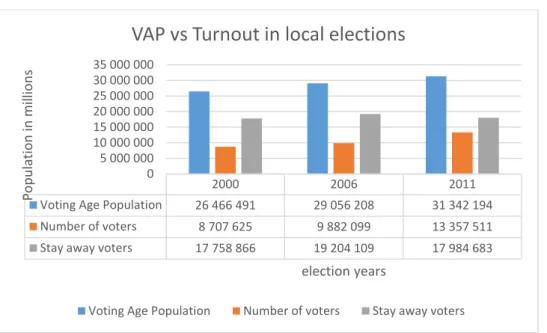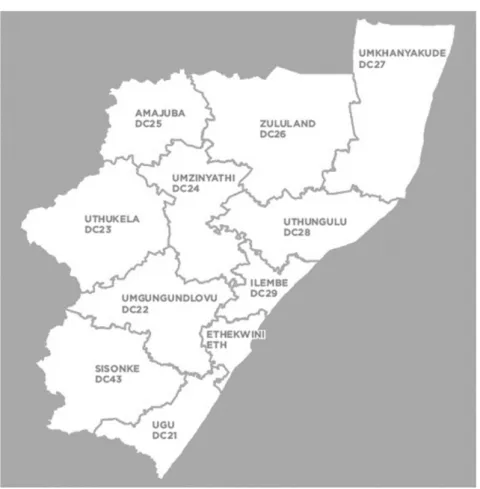The manipulability of electoral systems offers election engineers and policymakers an opportunity to improve turnout in local elections. Table 1: shows the turnout percentages in national and local elections held to date. Table 2: Voter turnout by province in the 2011 state and local government elections.
Introductory Remarks: electoral system-voter turnout nexus
That is to say - how and to what extent the operation or special features of the electoral system shape the political playing field and limit or facilitate participation in the elections. The literature offers mixed (if noisy) findings about the direction and extent to which the structure of the electoral system shapes the levels and dynamics of electoral participation in different contexts.
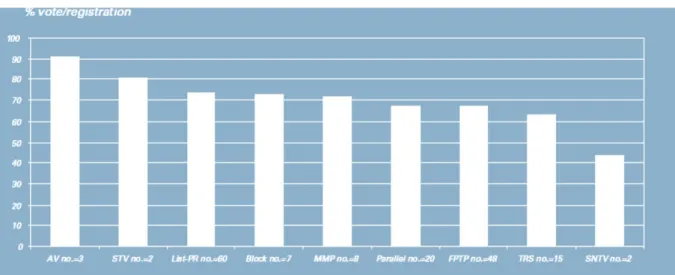
The importance of elections and electoral participation
Moreover, participation in the election is also a measure of the degree of voters' awareness or sense of civic duty as citizens. Schumpeter (1944) advocates an indirect democracy where the participation of the masses is limited to electing the leaders.
A glance on the context
The study analyzes turnout patterns in the 2011 municipal elections in the 50 local municipalities, clustered among 10 district municipalities and one metropolitan municipality10, with the aim of shedding more light on the influence of the electoral system on turnout. Franklin (2004: 4) advises that when examining turnout it is important to focus on both the character of the election and the characteristics of the electorate.
Electoral participation patterns in South Africa
- Voter turnout: From another angle
This study is interested in the relationship, if any, between the electoral rules used for the local elections and the observed variations in levels of turnout. Figure 1 below shows quite interesting trends in the voting behavior of the South African voters.

Key research questions
Is there any systematic correlation between the type of electoral system in place and the level of turnout in local government elections in KZN. To assess the effect of various components of the electoral system structure on the level of electoral participation.
Significance of Study
Against this background, this study aims to contribute to the knowledge of the dynamics of electoral participation in local elections with the aim of finding sustainable solutions for the high prevalence of apathy or abstention among the electorate. Most previous studies on turnout in local elections have tended to focus too much on how individual factors such as race, education, class, and occupation affect turnout (Fauvelle-Aymar, 2008; Muhlbock, 2012).
Limitations of the Study
Structure of the dissertation
It will discuss the conceptualization and operationalization of the dependent variable (voting turnout) and various independent variables (disproportionality, district size, quotas, and party system). The final chapter of the dissertation will summarize the findings of the study and present a final statement on the impact of the electoral system on voter participation.
Conclusion
It will report on and interpret the collective impact of the specified independent variables on the dependent variable – voter turnout across KZN Province constituencies. The next chapter will examine the existing scholarship on the topic, focusing on the findings of the previous studies and their implications.
Introductory remarks
Electoral research: A historical detour
Specifically, to determine the factors that influenced their vote choice by voters in the election. The rational choice theory's analysis of political behavior is based on an analogy of a consumer's behavior in the marketplace.
Conceptualisation and operationalization of Voter Turnout
Furthermore, 13 studies define turnout as a ratio of the voting eligible population (VEP), a method devised by McDonald and Popkin (2001). The most common definitions of voter turnout used in the literature are the ratio of the voting age to the ratio of registered voters.
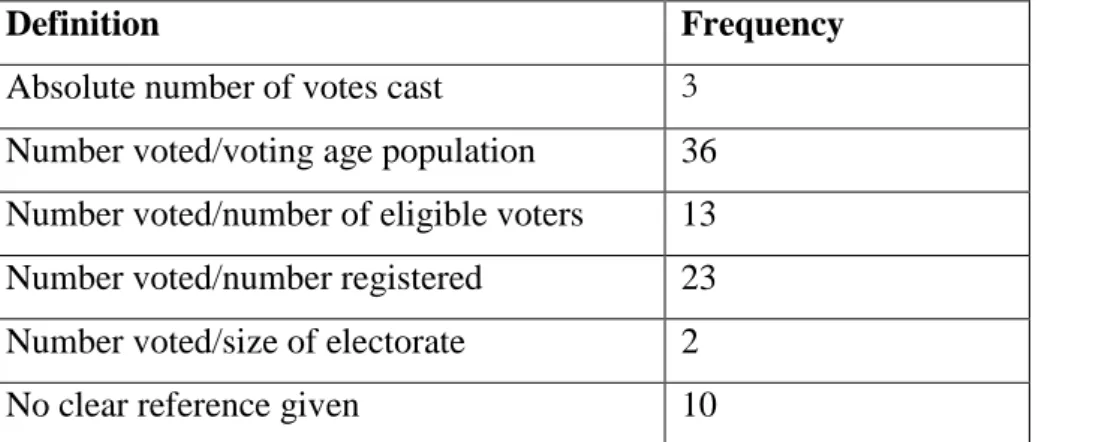
The electoral system: conceptualisation
- The majoritarian system
- The Proportional Representation system
- The Mixed system
Party bloc voting (PBV) is used in multi-member units in which voters cast a single party-centric vote; the party with the most votes wins all the seats in the district. A mixed conditional system is one in which a particular effect of one formula requires the use of another.
Electoral systems and voter turnout
- Turnout and district magnitude
- Turnout and disproportionality
- Turnout and party system
Jackman (1987) and Blais and Carty (1990) report negative and nonsignificant results when examining the relationship between disproportionality and voter turnout in industrial democracies. Most studies, however, reported a negative relationship between the number of parties and voter turnout (Jackman, 1987; Blais and Carty, 1990; Blais and Dobryznska, 1998; Jackman and Miller, 1995; Kostadinova, 2004).
Local and African literature
Furthermore, studies have been done on the impact of the electoral system on the representation of women in South Africa, but not necessarily on voter turnout (Ballington, 1998; Bratton, 2002; Ballington, 2004; Nkiwane, 2007). This is because these studies hint that the representation of the electoral system is a quality that gives significant shape to voters.
A Critique
It is this gap that the present study aims to address as it investigates the impact of electoral rules on voter turnout patterns in KZN local elections. The study argues that understanding the relationship between electoral rules and voter turnout will remain incomplete without understanding how these variables relate to local elections.
Conclusion
Second-order or sub-national elections such as local elections have been largely neglected in the established literature (Ladner and Milner (1999). The majority of studies in the literature seem to prefer the 'main street of political science', which focuses mainly on cross-border research into political science, electoral participation and more often than not in national elections.
Introductory remarks
Finally, it will describe how the system works in the KZN context, with a view to understanding how it shapes electoral participation.
The Local government in South Africa: A brief background
The first, pre-interim phase started with the introduction of the Local Government Transition Act 209 of 1993 (LGTA) and the establishment of negotiation forums in local authorities in anticipation of the first local government elections. The third and final phase began with the municipal elections in December 2000, when the current municipalities were established.
The functions and structure of the local government
This process was informed and supported by the need to entrench democratic practices of equality, transparency, accountability and non-discrimination within the operations and structures of the local municipalities. This came after the government's adoption of the 1998 White Paper on Local Government which developed a framework for the transformation of the local government system.
Electoral rules for local elections in South Africa
For example, the application of the PR rules does not depend on the outcome of the single-member district systems. The choice of the mixed system was guided by the need to balance representation and inclusiveness with accountability and justice as emphasized in the constitution (Fakir, 2014).
Local and Metropolitan councils
The mixed system is used without exception in all local elections in the country, as prescribed in the constitution. The majoritarian element of the electoral system promotes accountability as council representatives are forced to be directly accountable to their constituencies and not to the party.
District councils
A constituency-based system is based on plurality, with the candidate with the highest number of votes winning the seat, even if they do not secure an absolute majority. The constituency-based system and the PR system create a number of seats equal to the number of wards in a local or metropolitan municipality.
The process of translating votes into seats for the parties
Parties are then allocated seats in the council by dividing the number of votes they got by dividing the quota number. Party B candidate in the table illustration above will win the ward seat based on the highest number of votes.
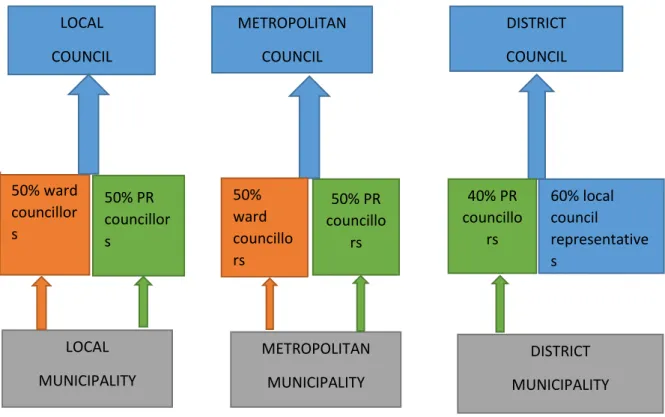
Seat allocation using the PR system: An in-depth look
As the above example shows, a party must win at least one council seat under the PR seat allocation system if it wants to collect at least 10,751 votes. After determining the quota, the next step is the distribution of mandates to the parties according to the number of votes they managed to get in the elections (IEC, 2014).

Allocation of seats in the district council
As shown in Table 6 above, parties A and C have the largest residuals from the first allocation and are therefore allocated the remaining seats. Party C with the largest remainder gets the first seat and party A with the second largest remainder gets the second seat.
The Case Study: KwaZulu Natal Province
The district municipalities are further divided into 49 local municipalities, each consisting of between 3 and 7 local municipalities that also mark the electoral districts (The Local Government Handbook, 2012).
Socio-economic background of KZN: Important statistics
EThekwini, the only metro municipality in the province, is the most racially diverse with the largest number of Indians, whites and blacks, with blacks making up a relatively lower proportion of the population. With an average of more than 30 percent of people aged 0 to 14 and an average of people aged 65 and over well below 10 percent, the province's population is young.
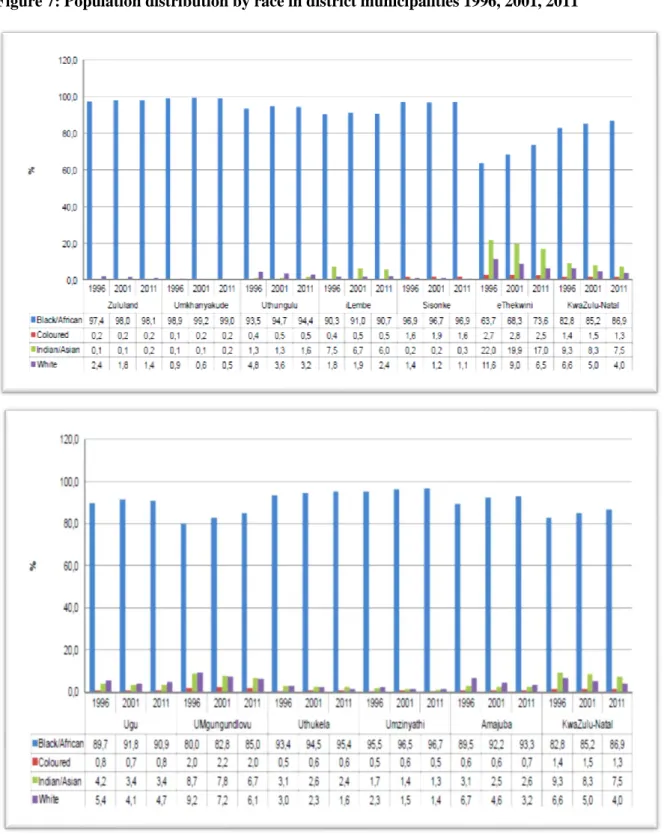
Qualities of electoral systems: Evaluation criteria
- Representativeness
- Government effectiveness and accountability
- Making elections more accessible and inclusive
The choice of electoral system is determined by and reflects the historical, social and political circumstances of the society in question. The accountability of those elected to the voters is crucial for an effective and efficient democratic system.
Concluding remarks
Introductory remarks
Hypotheses and assumptions
How the electoral system affects turnout rates: Connecting the dots
- Electoral choice and diversity of options
- Electoral decisiveness
- Electoral costs and benefits
The type of electoral systems in place affects the decisiveness of the vote to varying degrees (Norris, 2003; Chen, 2011; Blais and Aarts, 2006). Jackman suggests that the tendency of the PR system to produce coalition governments is likely to reduce the certainty of the vote and therefore discourage turnout.
The rational choice theory
They argue that since voting is a highly political motive, leaving it out of the voting bill is ridiculous. Last but not least, there is the satisfaction of establishing one's effectiveness in the political system.
Institutionalist Perspective on Voter Turnout
The approach departs from previous models in that it shifts the focus from individual voters to the character of elections to explain variation in turnout. Therefore, this study investigates the effects of the electoral system on KZN municipal election turnout with cautious optimism.
The Institutionalist-Rational Choice Theory: The Link
The mechanics of the electoral system will have definite psychological effects on the political actors in electoral politics and thus affect the level of voter turnout. This research problematizes the relationship between the various characteristics of the electoral system and the level of electoral participation.
The Sociological Model
Electoral laws and regulations provide different incentives or disincentives to participate and therefore influence the propensity of political actors to participate in elections. In a sense, this model shows how social institutions such as family and religion can shape voters' behavior in terms of their likelihood to participate in elections (Antunes.
The Michigan/ Party Identification Model
However, the model has been criticized for sociological determinism, as it reduces all political behavior to social explanations. Voting behaviour, the model maintains, can be influenced by more immediate factors such as the issues dominating the election and the candidates involved (Bartel, 2008: 10).
Concluding remarks
It recognizes the important role of the larger social and political forces, but does not ignore the effect of individual predispositions and short-term factors on political participation. In the same way, the mechanics of the electoral system do affect the voters psychologically and influence them to act in a certain way (remember or turn out).
Introductory remarks
Quantitative and qualitative methods: The debate
Even in the work of the most statistically minded people, qualitative analysis will have its place. However, due to the nature of the research, the research will be mainly, but not exclusively, based on quantitative methods and techniques.
Methodological approaches employed by previous studies
In an international examination of the effect of electoral systems on turnout, Endersby and Krieckhaus (2008) used the ordinary least squares (OLS) regression technique to analyze the relationship between two variables. The current study also aims to shed more light on the relationship between the various components of the electoral system and voter turnout.
Data collection
However, for the present study this is not much of a problem as information on the voting patterns of the electorate and the electoral system is covered extensively on the government websites and other sources. Controlling for these factors will make the model of the relationship between the electoral system and the level of voter turnout more robust and accurate.
Operationalization of the Dependent Variable
This study relies on the information on the websites of the Independent Electoral Commission (IEC)28 which has a comprehensive record of voter turnout rates for all the elections in South Africa. Kuenzi and Lambright justify their use of the percentage of registered voters to measure turnout by missing data in a significant number of countries in their data set.
Operationalization of independent variables
Attributes or components of the electoral system, such as disproportionality, district size, actual number of parties, and others, are continuous variables. This study uses the Loosemore-Hanby index to measure the proportionality of the electoral system in the 2011 KZN local elections.
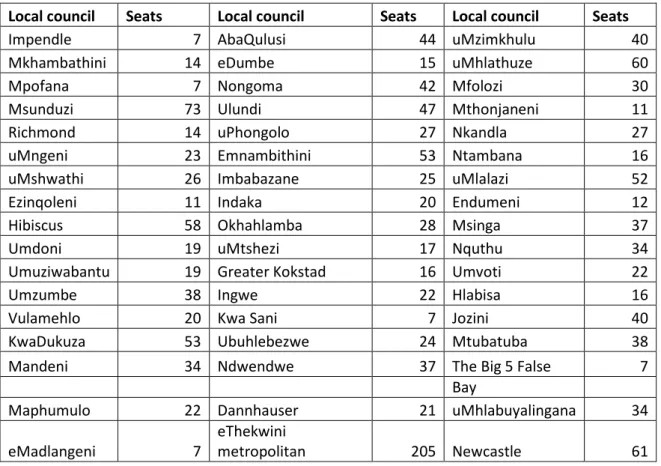
Additional variables
The methods and techniques
Concluding remarks
The first two are part of the mechanical design of the electoral system and the latter two mechanical effects of the electoral system. Examining how these variables affect the dynamics of electoral participation in KZN will improve the existing understanding of how the electoral system shapes electoral turnout.
Introductory remarks
Using a stepwise multivariate regression analysis, this chapter will demonstrate the impact (or lack thereof) of various components of electoral systems, as described in the methodology section, on turnout dynamics. This study acknowledges that expecting the South African electorate to consciously consider how electoral rules will affect the determination of their vote may be a tall order.
The election results: not a good story for small parties
For roughly the same number of votes, the ANC's dominance was significantly reduced as it won just 41% of the seats - a sharp drop from 70% in ward-based elections. This shows how the mechanical features of the electoral system can influence and shape election results.
Descriptive statistics of the variables: system skewed in favour of the big parties
Disproportionality33 has an average of 0.24 according to the FPTP system which means that on average 24% of the votes cast in the ward elections were not reflected in the result. According to the FPTP system, which reflects the dynamics of neighborhood elections, the effective number of electoral parties appears to have a fairly strong negative correlation with voter turnout with a value of 0.4.
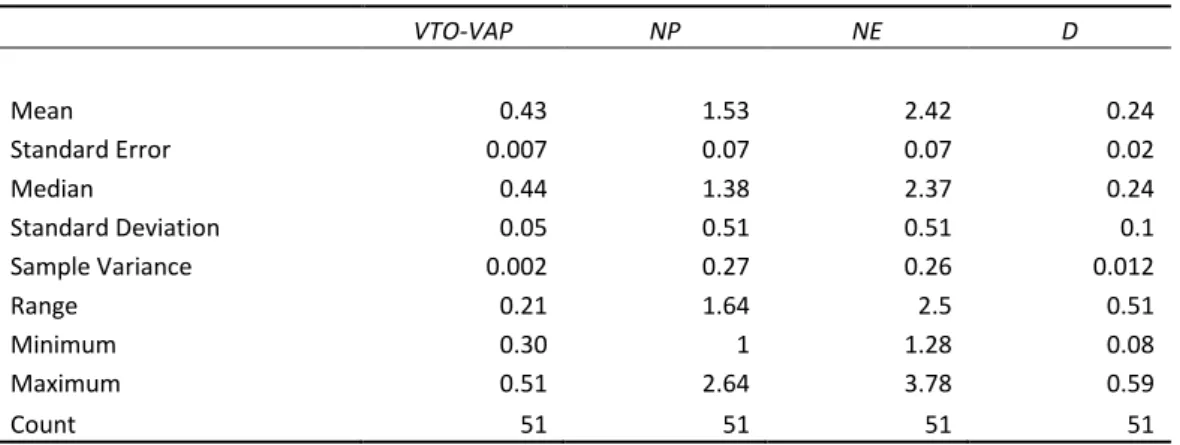
Regression analysis: results and models
This is similar to Barwig's results in his study of the impact of the electoral system in Morocco, where all variables were negative. The model explains only 15% of the variation in turnout observed in local municipalities in 2011.
Result analysis: electoral system-voter turnout relationship
- The FPTP system effect and rational choice assumptions
The FPTP component of the mixed system used in the ward-based elections appears to be biased in favor of the major parties and against the smaller parties. Furthermore, it is at least clear from observing the results in the ward-based elections that the electoral system in place does affect competitive dynamics between parties.
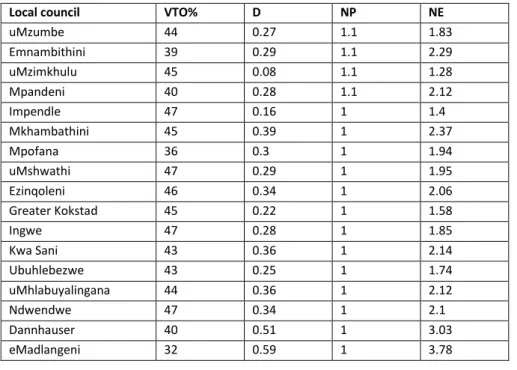
The PR system effect and rational choice assumptions
- District Size
- Effective number of parliamentary and elective parties
It is clear from the results that PR is able to promote a multi-party system in the election. That is, an increase in the size of the district has the effect of attracting even smaller parties to stand in the election.
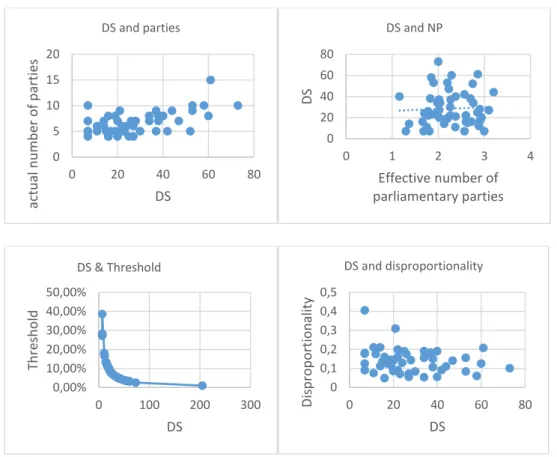
Implications for South Africa’s democracy
Even the introduction of a reasonably generous proportional system has failed to reduce the dominance of the major parties in elections. Currently, the electoral system in local elections is skewed in favor of the major parties such as the ANC, the DA, the IFP and the ANC.
Concluding remarks
And thus it can significantly influence participation in elections. For this reason, electoral rules can have an important psychological effect on the decision of parties and voters to participate or stay away from the elections.
Introductory remarks
No straight-forward relationship between electoral system and voter participation
Rational choice – Institutionalist paradigm
However, Stein et al (2005: 2) note that, in the final analysis, the effectiveness of the electoral system in promoting increased turnout will depend on the strategic decisions of political parties. Parties and candidates who want as many votes as possible will take advantage of the electoral system's incentives if higher voter turnout supports their cause.
Recommendations: possible remedies to voter apathy
- Voter education
- Hold local and national elections concurrently
- An open-list and a lower predetermined threshold for PR elections
- Compulsory voting
A possible solution for the low participation in local elections could be to hold local and national elections simultaneously. Compulsory voting also has the potential to address the systemic biases and imbalances inherent in the electoral system.
Limitations of the study and suggestions for future research
Creating a voter-friendly electoral system can be effective as a strategy to increase voter turnout in elections, but it has limits. Moreover, turnout is influenced by many factors other than the electoral system and is better analyzed holistically.

